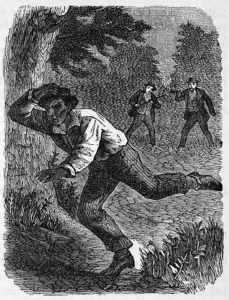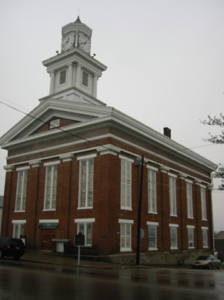
Dr. Darrel E. Bigham, from amUSIngArtifacts.org
An enslaved mother made the urgent decision to escape after she learned of her owner’s plans to sell several of her eight children. Because she was trusted to sell vegetables in the local market, she was able to hide her possessions in a wagon underneath a layer of produce. Then, she drove the cart to a spot south of Covington, Kentucky, on the Ohio River. Her husband and children met her there, and began their clandestine operation to cross the river into freedom officially underway. This was a success story: “She and her family eventually reached Canada,” Darrel E. Bigham writes in his 2006 book On Jordan’s Banks: Emancipation and Its Aftermath in the Ohio River Valley. While his book does not use the term ‘stampede’, it does include accounts of families, individual freedom seekers, and organized groups of people escaping. In addition, Bigham writes of enslaved people rebelling against slaveholders in a variety of ways.
Bigham writes, “[Slaves] who could not look forward to emancipation expressed opposition in many ways, mostly nonviolent – ranging from humor and music to work slowdowns or temporarily running away.”1 Even though many enslaved people knew that they would not be able to escape in the immediate future, they still purposefully rebelled against the slaveholders. One case involved an enslaved man who strangled his overseer “with his own suspenders.”2 Because the enslavers knew they were outnumbered, they often relied on intimidation to make their enslaved people believe that rebelling was not worth the danger they would be in afterward. “[O]wners took slaves to hangings, hoping to make an impression on them,”3 Bigham recounts. Clearly, enslaved people’s defiance made an impact.

Enslaved Man Escaping, from NYPL Public Domain Archive.
Interestingly, Bigham counters an assertion that this sort of pushback was “[enslaved people’s] most successful resistance.”4 He continues, “The error is not in celebrating their counterculture, but rather in failing to appreciate that only running away allowed blacks to ‘outplay whites in the divide-and-conquer’ game.”5 Even better, this form of mobile rebellion did not scare slaveholders in a way which caused them to retaliate violently against the slaves who had stayed. This leads into Bigham’s discussion of escapes. He writes that Black people took initiative in organizing their escapes, and emphasizes “that the Underground Railroad depended heavily on black agents” who were sometimes newly-free people who had taken similar routes out of slaveholding territory.6 Bigham includes several references to individual Black people escaping from their bondage with the help of abolitionists. For example, he relays the story repeated by “[t]he great-niece of a slave named Lewis Barnett” about her great-uncle, who “escaped with twelve others traveling through New Albany”, where they were hidden by a Black family for two days before being unfortunately recaptured.7

The Second Baptist Church, New Albany, VA, from Darrel Bigham.
Bigham includes a significant amount of geographical and cultural information about the Underground Railroad’s operations, and he makes a point to mention names and provides short accounts of both white and free black people who helped the runaways in their escapes. At the end of his book, Bigham includes pictures of primary sources, some of which are newspapers about anti-Black initiatives, an autographed autobiography of a Black reverend, and two nineteenth-century schools for African Americans. Those last photos are from the author’s collection. In fact, Bigham personally provides several pictures of important buildings like schools or churches which used to serve as stops on the Underground Railroad.
[1] Darrel Bigham, On Jordan’s Banks: Emancipation and its Aftermath in the Ohio River Valley (University Press of Kentucky, 2006), 22.
[2] Bigham, 22.
[3] Bigham, 22.
[4] Bigham, 22.
[5] Bigham, 22.
[6] Bigham, 24.
[7] Bigham, 47.
